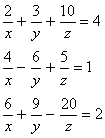![]()
CBSE Guess > Papers > Important Questions > Class XII > 2009 > Maths > Mathematics By Mr. Harish Kumar
CBSE CLASS XII
CHAPTER : 1 MATRICES
Q. 1. Using elementary transformations find the inverse of the following :
Q. 2. The sum of three numbers is 6. If we multiply third numbers by 3 and add second number to it, we get 11. By adding first and third numbers, we get double of the second number. Represent it algebraically and find the numbers using matrix method.
Q. 3. The cost of 4kg onion, 3kg wheat and 2kg rice is Rs60. The cost of 2kg onion, 4kg wheat and 6kg rice is Rs90. The cost of 6kg onion 2kg wheat and 3kg rice is Rs70. Find cost of each item per kg by matrix method.
Q. 4. The sum of three numbers is -1. If we multiply second number by 2, third number by 3 and add, then we get 5. If we subtract the third number from the sum of first and second, we get –1. Represent it by a system of equations. Find the numbers using inverse of a matrix.
Q. 5. Solve the following system of equations by matrix method :
Q. 6.

Q. 7.

Q. 8.

APPLICATION OF DERIVATIVES
Q. 1. Find two positive numbers whose sum is 15 and the sum of whose squares is minimum.
Q. 2. Find the numbers whose sum is 24 and whose product is as large as possible.
Q. 3. Find two positive numbers x and y such that x + y = 60 and xy3 is maximum.
Q. 4. Find two positive numbers x and y such that their sum is 35 and the product x2y5 is maximum.
Q. 5. Find two positive numbers whose sum is 16 and the sum of whose cubes is minimum.
Q. 6. Amongst all pairs of positive numbers with product 256, find those whose sum is least.
Q. 7. Find the shortest distance of the point (0, c) from the parabola y = x2.
Q. 8. An apache helicopter of enemy is flying along the curve given by y = x2 + 7. A solder placed at (3, 7) want to shoot down the helicopter when it is nearest to him. Find the nearest distance.
Q. 9. Let AP and BQ be two vertical poles at point A and B respectively. If AP = 16m, BQ = 22m and AB = 20m, then find the distance of a point R on AB from the point A such that RP2 + RQ2 is minimum.
Q. 10. If length of three sides of a trapezium other than base are equal to 10cm. Then find the area of the trapezium when it is maximum.
Q. 11. Prove that the radius of the right circular cylinder of greatest curved surface area which can be inscribed in a given cone is half of that of the cone.
Q. 12. A square piece of tin of side 18cm is to be made into a box without top by cutting a square from each corner and folding up the flaps to form the box. What should be the side of the square to be cut off so that the volume of the box is maximum possible?
Q. 13. A rectangular sheet of tin 45cm by 24cm is to made into a box without top by cutting off square from each corner and folding up the flaps. What should be the side of square to be cut off so that the volume of box is maximum?
Q. 14. Show that of all the rectangles inscribed in a given fixed circle, the square has maximum area.
Q. 15. Show that the right circular cylinder of given surface and maximum volume is such that its height is equal to the diameter of the base.
Q. 16. Show that height of the cylinder, open at the top, of given surface area and greatest volume is equal to the radius of its base.
Q. 17. A wire of length 28m is to be cut into two pieces. One of the pieces is to be made into a square and the other into a circle. What should be the length of the two pieces so that the combined area of the square and the circle is minimum?
Q. 18. Prove that the volume of the largest cone that can be inscribed in a sphere of radius R is ![]() of the volume of the sphere.
of the volume of the sphere.
Q. 19. Show that the right circular cone of least curved surface and given volume has an altitude equal to ![]() times the radius of the base.
times the radius of the base.
Q. 20. Show that the semi vertical angle of the cone of maximum volume and of given slant height is tan-1 ![]() .
.
Q. 21. Show that the semi vertical angle of the cone of given surface area and maximum volume is sin-1 ![]()
Q. 22. Find the maximum area of an isosceles triangle inscribed in the ellipse ![]() with its vertex at one end of the major axis.
with its vertex at one end of the major axis.
Q. 23. A window is in the form of a rectangle surmounted by semicircular opening. The total perimeter of the window is 10m. Find the dimensions of the window to admit maximum light through the whole opening.
Q. 24. A point on the hypotenuse of a triangle is at distance a and b from the sides of the triangle. Show that the minimum length of hypotenuse is 
Q. 25. Show that the altitude of the right circular cone of maximum volume that can be inscribed in sphere of radius R is ![]()
Q. 26. Show that the height of the cylinder of maximum volume that can be inscribed in a sphere of radius R is ![]() Also find the maximum volume.
Also find the maximum volume.
Q. 27. Show that the height of the cylinder of greatest volume which can be inscribed in a right circular cone of height h and semi vertical angle![]() is one third that of the cone and the greatest volume of the cylinder is
is one third that of the cone and the greatest volume of the cylinder is ![]()
Q. 28. A rectangle is inscribed in a semicircle with one of its sides on the diameter of the semicircle. Find the dimensions of the rectangle so that its area is maximum. Find also the area.
Q. 29. A window is in the form of as rectangle above which there is a semi circle. If the perimeter of the window is p cm. Show that the window will allow the maximum possible light only when the radius of the semicircle is 
Q. 30. Show that the height of right circular cylinder of maximum volume that can be inscribed in right circular cone of height h is ![]()
Q. 31. An open box with a square base is to be made out of a given quantity of card board of area c2 square units. Show that the maximum volume of the box is ![]()
Q. 32. The combined resistance R of two resistors R1 and R2 (R1, R2>0) is given by ![]() R1 and R2 = C (a constant). Show that the maximum resistance R is obtained by choosing R1 = R2.
R1 and R2 = C (a constant). Show that the maximum resistance R is obtained by choosing R1 = R2.
Q. 33. Find the shortest distance between the line y – x = 1 and the curve x = y2.
THREE DIMENSIONAL GEOMETRY
Q. 1. Find the equation of the plane through the line of intersection of the planes x + y + z =1 and 2x + 3y + 4 = 5 which is perpendicular to the plane x - y + z = 0.
Q. 2. A line makes ![]() with the diagonals of a cube, prove that
with the diagonals of a cube, prove that ![]()
Q. 3. Find the equation of the plane that contains the point (1,−1,2 ) and its perpendicular to each of planes 2x + 3y − 2z = 5 and x + 2y - 3z = 8.
Q. 4. Find the distance between the point (6,5,9 ) and the plane determined by the point A(3,−1,2 ) , B(5,2,4 ) and C(−1,−1,6 ) .
Q. 5. Show that the lines ![]() are coplanar.
are coplanar.
Q. 6. Find the co ordinates of the point where the line through the points A(3, 4, 1) and B(5, 1, 6) crosses the XY plane.
Q. 7. Find the co ordinates of the point where the line through the points (3, 4, 1) and (5, 1, 6) crosses the YZ plane.
Q. 8. Find the co ordinates of the point where the line through the points (3, - 4, - 5) and (2, -3, 1) crosses the plane 2x + y + z =7.
Q. 9. Find the equation of the plane passing through the point (- 1, 3, 2) and perpendicular to each of the planes x + 2y + 3z =5 and 3x + 3y + z = 0.
Q. 10. Find the equation of the plane which contains the line of intersection of the planes ![]() and which is perpendicular to the plane
and which is perpendicular to the plane ![]()
Q. 11. Find the distance of the point (−1,−5,−10) from the point of intersection of the line ![]()
Q. 12. Find the vector equation of the line passing through (1,2,3) and parallel to the plane ![]()
Q. 13. Find the vector equation of the line passing through the point (1,2,−4) and perpendicular to the two lines : ![]()
Q. 14. Prove that if a plane has the intercepts a, b, c and is at a distance p units from the origin, then ![]()
Q. 15. Find the image of the point (1,2,−1) in the plane 2x + y − z = 2 .
Q. 16. Find the image of the point (3,5,3) in the line ![]()
Q. 17. Find the angle between the lines x − 2y + z = 0 = x + 2y − 2z and x + 2y + z = 0 = 3x + 9y + 5z .
Q. 18. Find the distance of point (2,3,4) from the plane 3x + 2y + 2z + 5 = 0 , measured parallel to the line ![]()
Q. 19. Find the shortest distance and vector equation of the line of shortest distance between the lines given by ![]()
Q. 20. Find the shortest distance between the lines ![]()
Q. 21. Find the shortest distance between the lines ![]()
Q. 22. Find the length and foot of perpendicular from the point (1,1,2) to the plane ![]()
Q. 23. Find the Cartesian as well as the vector equations of the planes passing through the intersection of the planes ![]() which are at unit distance
which are at unit distance
from origin.
Q. 24. Find the foot of perpendicular from (1,2,−3) to the line ![]() Also find the length of perpendicular.
Also find the length of perpendicular.
Q. 25. Find the foot of perpendicular from (1,2,3) to the line ![]() Also obtain the equation of plane containing the line and the point (1,2,3) .
Also obtain the equation of plane containing the line and the point (1,2,3) .
LINEAR PROGRAMMING
Q. 1. A co-operative society of farmers has 50 hectares of land to grow two crops X and Y. The profit from crops X and Y per hectare are estimated as Rs. 10500and Rs.9000 respectively. To control weeds, a liquid herbicide has to be used for crops X and Y at rate of 20 liters and 10 liters per hectare. Further, no more than 800 liters of herbicide should be used in order toprotect the fish and wild life using a pond which collects drainage from this land. How much land should be allocated to each crop so as to maximize the total profit of the society?
Q. 2. A manufacturing company makes two models A and B of a product. Each piece of model A requires 9 labour hours for fabricating and 1 hour for finishing. Each piece of model B requires 12 hours for fabricating and 3 hours for finishing. For fabricating and finishing, the maximum labour hours available are 180 and 30 respectively. The company makes a profit
of Rs.8000 on each piece of model A and Rs. 12000 on each piece of model B. How many pieces of model A and model B should be manufactured per week to realize a maximum profit? What is maximum profit per week?
Q. 3. There are two types of fertilizers F1 and F2. F1 consists of 10 % nitrogen and 6% phosphoric acid and F2 consists of 5% nitrogen and 10% phosphoric acid. After testing the soil conditions, a farmer finds that she needs at least 14 Kg of nitrogen and 14 Kg of phosphoric acid for her crop. If F1 costs Rs. 6/Kg and F2 costs Rs.5 / Kg, determine how much of the each type of fertilizer should be used so that the nutrient requirements are met at minimum cost. What is the minimum cost?
Q. 4. A dietician has to develop a special diet using two foods P and Q. Each packet (containing 30 g) of food P contains 12 units of calcium, 4 units of iron, 6 units of cholesterol and 6 units of vitamin A. Each packet of the same quantity of food Q contains 3 units of calcium, 20 units of iron, 4 units of cholesterol and 3 units of vitamin A. The diet requires at least 240
units of calcium, at least 460 units of iron and at most 300 units of cholesterol. How many packets of each food should be used to minimize the amount of vitamin A in the diet? What is the minimum amount of vitamin A?
Q. 5. There are two factories located one at place P and other at place Q. From these locations, a certain commodity is to be delivered to each of three depots situated at A, B and C. The weekly requirements of the depots are respectively 5, 5 and 4 units of the commodity while the production capacity of the factories at P and Q are respectively 8 and 6 units. The cost of transportation per unit is given below :
From / To |
Cost (in Rs) |
||
A |
B |
C |
|
P |
160 |
100 |
150 |
Q |
100 |
120 |
100 |
How many units should be transported from each factory to each depot in order that the transportation cost is minimum? What will be the minimum transportation cost?
Q. 6. A dietician wishes to mix together two kinds of food X and Y in such a way that the mixture contains at least 10 units of vitamin A, 12 units of vitamin B and 8 units of vitamin C. The vitamin contents of 1 kg food is given below :
| Food | Vitamin A |
Vitamin B |
Vitamin C |
X |
1 |
2 |
3 |
Y |
2 |
2 |
1 |
One kg of food X costs Rs.16 and one kg of food Y costs Rs.20. Find the least cost of the mixture which will produce the required diet?
Q. 7. A manufacturer makes two types of toys A and B. Three machines are needed for this purpose and the time (in min) required for each toy on the machines is given below :
Types of Toys |
Machines |
||
I |
II |
III |
|
A |
12 |
18 |
6 |
B |
6 |
0 |
9 |
Each machine is available for 6 hours a day. If the profit on each toy of type A is Rs.7.50 and that on each toy of type B is Rs.5. Show that 15 toys of type A and 30 of type B should be manufactured in a day to get maximum profit.
Q. 8. Two godowns A and B have grain capacity of 100 quintals and 50 quintals respectively. They supply to three ration shops D, E and F whose requirements are 60, 50 and 40 quintals respectively. The cost of transportation per quintal from the godowns to the shops are given
in the following table :
Transportation cost per quintal (in Rs) |
||
From/ To |
A |
B |
D |
6 |
4 |
E |
3 |
2 |
F |
2.50 |
3 |
How should the supplies be transported in order that the transportation cost is minimum? What is the minimum cost?
Q. 9. An oil company has two oil depots A and B with capacities of 7000L and
4000Lrespectively. The company is to supply oil to three petrol pumps D, E and F whose requirements are 4500L, 3000L and 3500L respectively. The distances (in km) between the depots and the petrol pumps is given in the following table :
| Distance (in Km) | ||
From/ To |
A |
B |
D |
7 |
3 |
E |
6 |
4 |
F |
3 |
2 |
Assuming that the transportation cost of 10 litres of oil is Re.1 per km, how should the delivery be scheduled in order that the transportation cost is minimum? What is the minimum cost?
ANSWERS
MARICES AND DETERMINANTS
1.i. 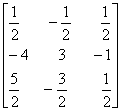
ii. 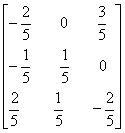
iii. 
iv. 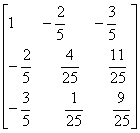
v. 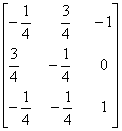
2. 1 ,2, 3
3. Cost of 1 kg of onion =Rs.5, Cost of 1 kg of wheat=Rs.8, Cost of 1 kg of rice =Rs.8
4. ![]()
5.i. 1, 2, 3
ii. ![]()
iii. x = 2, y = -1, z = 1
iv. x = 1, y = 2, z = -1
v. x = 2, y = 1, z = 3
vi. x = 2, y = 3, z = 5
vii. x = -1, y = -2, z = -3
viii. x = -2, y = 1, z = 2
6. 
7. x = 0, y = 5, z = 3
8. x = 2, y = -3, z = 2
APPLICATION OF DERIVATIVES
1. ![]()
2. 12, 12
3. 45, 15
4. 25, 10
5. 8, 8
6. 16, 16
7. ![]()
8. ![]()
9. 10.
10. ![]()
12. 3cm
13. 5cm
17. ![]()
22. ![]()
23. ![]()
26. ![]()
28. ![]()
33. ![]()
APPLICATION OF INTEGRATION
1. 
2. ![]()
3. ![]()
4. 4 5.7 sq units
6. 16 sq units
7. ![]()
8. 
9. ![]()
10. ![]()
11. ![]()
12. ![]()
13. ![]()
14. ![]()
15. ![]()
16. 4 sq units
17. ![]()
18. 5 sq units
19. ![]()
20. 27 sq units
21. 7 sq units
22. ![]()
23. ![]()
24. ![]()
25. ![]()
26. ![]()
29. ![]()
30. 4 sq units
31. 4 sq units
32. ![]()
34. ![]()
35. ![]()
36. ![]()
THREE DIMENTIONAL GEOMETRY
1. x – z + 2 = 0
2. 5x – 4y – z = 7
3. ![]()
5. 0
6. ![]()
7. ![]()
8. (1, -2, 7)
9. 7x – 8y + 3z + 25 = 0
10. 33x + 45y + 50z – 41 = 0
11. 13
12. ![]()
13. ![]()
15. (-1, 1, 0)
16. ![]()
17. 7
18. ![]()
19. (-1, 1, 7)
20. ![]()
21. ![]()
22. ![]()
23. (3, 5, 9)
24. ![]()
25. ![]()
Paper By Harish Kumar PGT Mathematics , JNV Jalandhar, Ph No. 09463647493










